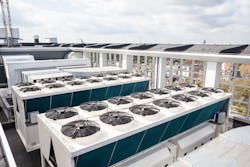It’s no longer “business as usual” in the world of HVAC: New technologies are turning the industry on its head by making the training, manufacturing and installing processes more efficient. Many instruments in the trade are getting a facelift, new applications are being introduced, and other key operations are using digital tools and internet connectivity. The impact of modern technologies on the HVAC industry seemingly has no end in sight.
Here are five of these new technologies and how they are driving efficiency for users and service technicians alike.
1. 3D Printing
The evolution of 3D printing started as a marathon in the 1980s and evolved into a sprint around 2013, when the technology became more accessible and affordable. Today, the speed and versatility of 3D printing means it’s creating everything from bespoke medical devices to specialized prototypes and parts for HVAC units – and even the units themselves.
In the HVAC industry, 3D printing is used to create missing or custom pieces with precision; these 3D printed custom pieces are also more efficient and durable than their traditional counterparts. That’s because they are created with a layering process that leaves no seams, offering better resistance.
Related: Internet of Things: How IoT Devices Enable Predictive Maintenance
While 3D technology makes it easier to replace a single part, it could also reinvent how manufacturers construct entire HVAC units. For instance, 3D printing may provide a solution for a customer who needs a customized unit installed in a particularly awkward spot. The 3D printer could create a custom unit in half the time – and with less material waste– than traditional manufacturing methods, resulting in a quicker turnaround and less of an environmental impact.
2. Virtual Reality
Virtual reality (VR) is a favorite simulation method used in the video game industry, but this technology has additional, more practical uses. Companies in various industries are using VR to help with employee training, virtual tours, live streaming events and other real-world applications.
In the HVAC industry, VR could help clients visualize the blueprints of a room or building for better spatial recognition. It could be used to view the inner workings of a machine so technicians could see how to best service and repair a unit. VR could even be used to show potential clients a virtual representation of their proposed HVAC system, offering customers newfound transparency into the construction of their system.
VR also aids in the training of employees, allowing new hires and seasoned veterans alike to try their hand at servicing or repairing HVAC units and other equipment in a risk-free environment.
3. Smart Thermostats
Digital thermostats offer many advantages over traditional models, including accessibility and ease of use, with most smart thermostats being controlled from a smartphone or tablet. Smart thermostat technology gives users the ability to remotely manage the temperature in their home to help them save money on energy costs.
Beyond their usability, smart thermostats have helped to revolutionize HVAC systems. With smart thermostats, HVAC units are now more energy efficient, customizable, and compatible with smart home technologies.
4. Internet of Things
From cars to refrigerators, universal wireless connectivity, known as the Internet of Things (IoT), is changing how devices work and interact with one another.
Smart thermostats are one example of the HVAC industry ties to the IoT. For example, a Wi-Fi connected HVAC system could use preventative diagnostics to detect potential errors instead of relying on user recognition or a system malfunction. Upon detection (and with help from IoT-connected devices), the system could send a service notification to the owner or repair team. It could also take measures to remedy any further damage, like resetting or powering down the system.
Internet-enabled HVAC units (with the help of smart thermostats) are also more capable of detecting changes in their environment and making automatic adjustments to keep a room or space comfortable.
5. Air Purification
Technology advances in HVAC aren’t just for convenience – they’re also improving health and safety. Air purification methods are getting smarter as customers push for ways to keep air safe. Specifically, consumers are focused on getting rid of VOCs and common allergens, which can cause poor air quality.
On topic: 4 HVAC Tips to Improve IAQ
One of the ways that technology is improving air purification is through the monitoring of air quality and air filters online. Some of the top air purification technologies have come from NASA. For example, a system can notify a user when a filter needs to be replaced or when the air quality is poor. These systems expertly marry energy efficiency with streamlined air cleaning methods for the best air quality.
HVAC Industry Embraces Technology
The HVAC industry is entering the 21st century in a major way. Users are demanding more intuitive, energy efficient models, and the industry is responding in turn with smarter technologies.
End users aren’t the only beneficiaries: HVAC companies are also seeing positive gains in how they service their customers. These exciting technological advances could help create a more cost-effective and more energy efficient industry in the not too distant future.
Kevin Burns is the President of Bob Jenson Air Conditioning in San Diego with over 29 years of experience in the HVAC Field. He has worked in every aspect of the industry and has trained dozens of people. He has a passion for doing what’s right for each home and customer and sets this standard for his entire team.
Two hand-picked articles to read next:
